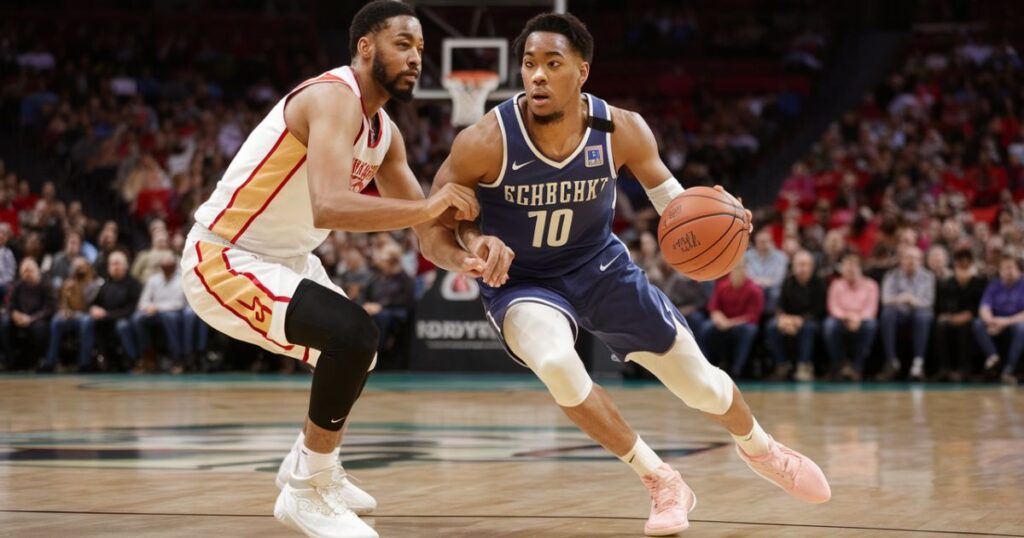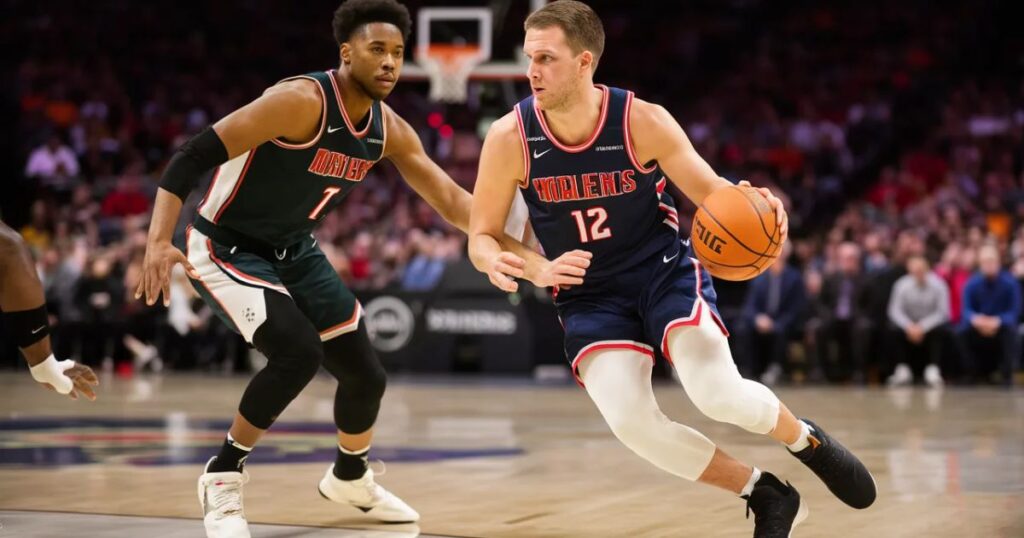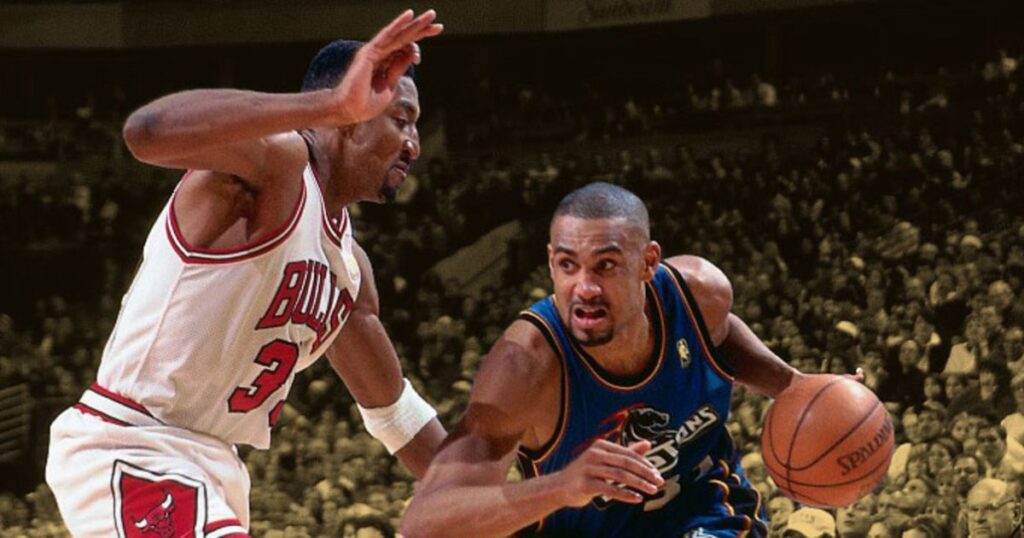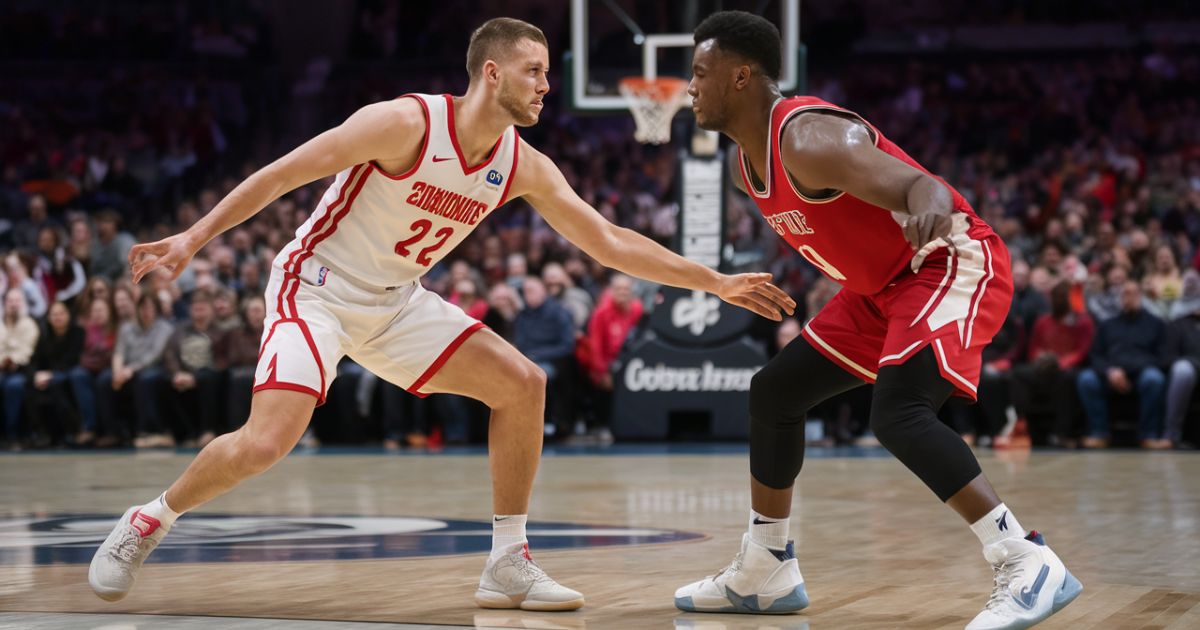In the fast-paced world of basketball, a split-second decision can make all the difference. Imagine a skilled guard driving towards the basket, only to be halted by the defensive player’s hand firmly planted on their chest.
This defensive tactic, known as hand checking, was once a common sight on the court. However, as the game evolved, so did the rules surrounding this controversial move.
Join us as we delve into the intricate details of hand checking, unraveling its impact on the game and the debates that continue to swirl around it.
What is Hand Checking?
Hand checking in basketball refers to the illegal act of a defensive player using their hands or arms to impede the movement of an offensive player with the ball.
It was once a widely accepted and utilized defensive strategy, allowing defenders to physically control and restrict the ball handler’s progress by placing a hand or forearm on their chest, hips, or arms.
Times have changed, and hand checking is now considered a personal foul in basketball. The rules have been modified to promote a more free-flowing, high-scoring game while prioritizing player safety.
Examples of Hand-checking
To better understand what constitutes a hand-checking foul, let’s explore a few common scenarios:
- Against a Driving Player: A defender momentarily places both hands against the torso of an offensive player driving to the basket, attempting to slow their progress.
- Using an Arm Bar: A defender guides a driving offensive player away from the basket by extending an arm across their body, effectively creating a barrier.
- In the Post: A defender positions one hand with a bent elbow on the back of an offensive post player with the ball, restricting their movement and ability to turn towards the basket.
- Multiple Touches: A defender pressuring an offensive ball handler repeatedly places their hands on the ball handler’s torso or arms, disrupting their rhythm and movement.
These examples illustrate the various situations where hand-checking fouls are likely to be called, as the defensive player illegally uses their hands or arms to physically impede the offensive player’s movement.
Hand Checking Result

When a hand-checking foul is called, it counts as a personal foul against the offending defender. Accumulating too many personal fouls can lead to disqualification from the game.
The offensive team retains possession of the ball, and the shot clock is reset, allowing them to reset their offensive play. In certain situations, such as when the offensive team is in a bonus situation, the hand-checking foul may also result in free throw attempts.
Hand Checking vs. other Defensive Fouls
It’s important to differentiate hand checking from other defensive fouls that involve illegal contact:
- Holding: This occurs when a defender grabs or clutches an offensive player’s uniform or body, preventing them from moving freely. Hand checking involves touching without grabbing.
- Pushing: This foul occurs when a defender uses force to displace or move an offensive player by pushing or bumping them. Hand checking is more about controlling movement rather than forcefully displacing the player.
- Blocking: A blocking foul happens when a defender improperly positions their body to impede the path of an offensive player with the ball, often resulting in significant contact.
While hand checking involves illegal hand or arm contact, it’s a distinct foul from these other defensive violations, each with its own set of rules and consequences.
Hand Checking in the NBA
The history of hand checking in the NBA is a tale of evolution and adaptation. In the early years of the league, hand checking was a commonplace defensive tactic.
Defenders were permitted to lightly touch the player they were guarding, using their hands on the arm, wrist, or leg to control and restrict their movement.
As the game progressed and the league sought to increase scoring and entertainment value, the rules surrounding hand checking began to tighten.
In 1995, the NBA introduced restrictions on hand checking, prohibiting the tactic from the backcourt baseline to the opposite foul line. This was a precursor to the more significant change that would come nearly a decade later.
Ahead of the 2004-2005 NBA season, the league made a pivotal decision – hand checking was banned entirely. From that point forward, any hand contact by a defender on an offensive player became an automatic foul, with few exceptions.
This rule change was partly influenced by the league’s desire to showcase the incredible talents of offensive superstars like Michael Jordan, who had recently retired, by reducing the physicality of defensive play.
The Impact of Hand-Checking Rule Changes

The NBA’s decision to ban hand checking in 2004 set in motion a series of profound changes that reshaped the game of basketball. Gone were the days of physical, grappling defense; instead, a new era of finesse, speed, and offensive prowess emerged.
Gameplay Pace and Scoring Changes
One of the most noticeable impacts of the hand-checking ban was the acceleration of gameplay and an uptick in scoring. Without the ability to slow down ball handlers through physical contact, games became faster-paced and more free-flowing.
Offensive players could navigate the court with greater ease, leading to more scoring opportunities and higher point totals.
In the 2003-2004 season, the last before the hand-checking ban, the league average for points per game was 93.4.
By the 2005-2006 season, this figure had risen to 97.2, reflecting the newfound offensive freedom. Teams like the Phoenix Suns, led by Steve Nash, embraced the up-tempo style, ushering in a new era of high-scoring, entertaining basketball.
Shift in Player Strategies
The hand-checking rule change also had a profound impact on the strategies employed by players and the roles they assumed on the court.
Guards and perimeter players, once hindered by the physical defense of hand checking, suddenly found themselves with more room to operate and showcase their skills.
Players like Steve Nash, Allen Iverson, and later Stephen Curry, became even more dangerous, utilizing their quickness and ball-handling abilities to carve through defenses and create scoring opportunities.
This shift in strategy was further exemplified by the trend in NBA Most Valuable Player (MVP) awards, which began to favor scoring guards over traditional big men.
In the pre-hand-checking era, dominant centers like Shaquille O’Neal and Tim Duncan were frequent MVP recipients, but after the rule change, the award was often bestowed upon skilled perimeter scorers like Nash, Kobe Bryant, and LeBron James.
Effect on Defensive Play
With hand checking no longer a viable defensive option, players were forced to adapt their strategies and focus on different aspects of defensive play.
Size and strength, once crucial assets for physically controlling offensive players, took a backseat to quickness, anticipation, and strategic positioning.
Defenders had to rely more on their lateral movement, footwork, and overall basketball IQ to effectively contest shots and disrupt offensive flow without resorting to illegal hand contact.
This shift in defensive priorities led to a greater emphasis on team defensive schemes, communication, and help defense principles.
Former NBA guard Kenny Smith eloquently summarized this change in physicality during a segment on Inside The NBA, stating, You had to use your mind more than your body. You had to be quicker, you had to be smarter, you had to have better technique.
Controversies and Debates Surrounding Hand-Checking

While the hand-checking ban undoubtedly reshaped the game, it has also sparked ongoing debates and controversies within the basketball community. Proponents and critics alike have weighed in on the merits and drawbacks of this rule change, fueling a passionate discourse.
Arguments For the Hand Check Ban
Supporters of the hand-checking ban, including many league officials and fans, cite several key benefits:
- Increased Scoring and Entertainment Value: The ban has led to higher-scoring games, which are often considered more exciting and entertaining for fans. The increase in offensive production and highlight-reel plays has helped grow the sport’s popularity.
- Player Safety: By reducing physical contact and excessive grabbing, the hand-checking ban has helped minimize the risk of injuries, particularly for offensive players who were previously subjected to significant physical resistance.
- Showcasing Skill and Talent: With fewer restrictions on offensive movement, the ban has allowed players to showcase their full array of skills, from lightning-quick handles to acrobatic finishes at the rim. Fans can appreciate the true talent of the game’s elite players.
Arguments Against the Hand Check Ban
On the other hand, critics of the rule change, often former players and purists of the game, argue that the hand-checking ban has had detrimental effects:
Defensive Integrity: Many argue that the ban has made defense too limited, taking away a crucial element of the game. It has given an unfair advantage to offensive players, making it increasingly difficult for defenders to effectively contest shots and drives.
- Disruption of Traditional Balance: Critics contend that the hand-checking ban has fundamentally altered the balance between offense and defense, shifting the game too heavily in favor of offensive production. This imbalance, they argue, goes against the traditional principles of basketball.
- Change in Game Dynamics: The rule change has reshaped the dynamics of the game, with some arguing that it has favored a more individualistic, isolation-heavy style of play. This contrasts with the team-oriented, movement-based offenses that were prevalent in the past.
FAQs About Hand Checking in Basketball
To further clarify the intricacies of hand checking, let’s address some frequently asked questions:
What is hand checking in basketball?
Hand checking in basketball refers to the illegal act of a defensive player using their hands or arms to impede the movement of an offensive player with the ball. It is considered a personal foul.
When was hand checking banned in the NBA?
Hand checking was officially banned in the NBA before the start of the 2004-2005 season, marking a significant shift in the league’s rules and playing style.
Is body checking legal in basketball?
No, body checking is not legal in basketball. It is considered a foul as it involves using the body to block or impede an opponent’s movement, rather than just the hands or arms.
What rules did the NBA change for Jordan?
The NBA did not change any specific rules directly for Michael Jordan. However, rule changes in the late 1980s and 1990s, such as the gradual crackdown on hand-checking, benefited offensive superstars like Jordan by reducing the physicality of defensive play and allowing them to showcase their skills more freely.
How does hand-checking impact a basketball game?
Hand-checking slows down the pace of the game and makes it more difficult for offensive players to score. When hand-checking is allowed, games tend to be lower-scoring and more physical, with a greater emphasis on defensive strategies.
How do referees call hand-checking in games?
Referees call hand-checking fouls when they observe a defender illegally using their hands or arms to control or impede the movement of an offensive player with the ball. It is often a judgment call based on the level of contact and the perceived intent of the defensive player.
Could hand-checking ever make a comeback?
It is highly unlikely that hand-checking will make a significant comeback in the NBA or other major basketball leagues. The current rules and preferences lean towards a more offensive-oriented, high-scoring style of play, making it improbable that the league would revert to allowing the level of physical contact associated with hand-checking.
Conclusion
The evolution of hand checking in basketball has been a journey of adaptation, controversy, and strategic shifts. From its humble beginnings as a common defensive tactic to its current status as an illegal form of contact, the rule changes surrounding hand checking have reshaped the very fabric of the game.
As you’ve learned, the hand-checking ban has had far-reaching implications, influencing everything from scoring totals and player strategies to the fundamental balance between offense and defense. While debates persist on the merits and drawbacks of this rule change, one thing is certain: understanding hand checking is crucial for any true student of the game.
Whether you’re a seasoned basketball enthusiast or a newcomer to the sport, mastering the intricacies of hand checking will deepen your appreciation for the nuances of defensive play and the ever-evolving nature of the game. So embrace the knowledge, engage in the discourse, and enjoy the fast-paced, high-scoring spectacle that modern basketball has become.



